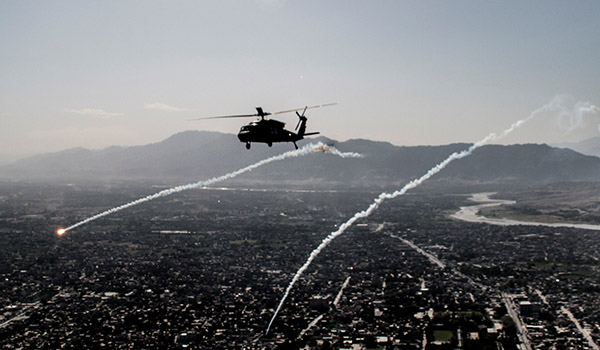
Tech Talk / By Mr. Corbin Stillwell: The Army Military Airworthiness Certification Criteria (AMACC) developed by the U.S. Army Development Command Aviation& Missile Center (DEVCOM AvMC) is the guiding document for Airworthiness (AW) Qualification for Army aviation.

A California Army National Guard UH-60 Black Hawk helicopter from Company B, 1st Battalion, 140th Aviation Regiment, 40th Combat Aviation Brigade, fires countermeasures while flying over Jalalabad, Afghanistan, May 20, 2016. / U.S. ARMY PHOTO BY SSG IAN M. KUMMER, 40TH CBT. AVN. BDE. PUBLIC AFFAIRS
Aircraft Survivability Equipment (ASE), though considered non-flight-critical, is covered in the AMACC. The AMACC defines the purpose of ASE as follows, “… to provide notification of, and protection from, threats to the aircraft.” This article explains some of the rationale behind inclusion of qualification criteria, their interconnectedness, and some operational impacts.
It is important to understand the information needed by the DEVCOM AvMC for determination of the AW of an ASE suite. Because ASE includes everything from threat warning systems, Radio Frequency (RF) and Infrared (IR) jammers and expendable countermeasures (i.e., chaff/flares), the AMACC covers several functional areas.
Section 17.4.2, Safe Clearance Analysis, gives the criteria for the prevention of chaff or flare strikes on the aircraft. The impact of an engine ingesting a flare/chaff cartridge cannot be understated; however, strikes on rotors, other control surfaces, and munitions held on wings/pylons must also be considered. Not only is there the potential for damage to other mission equipment, but there is the strong possibility of greatly degrading the effectiveness of the countermeasure being deployed. Safe clearance should be verified early in the development and integration of an expendables onto a platform.
The interconnectedness of sections 17.4.3 – Safety Inhibits to Prevent Dispensing, 17.4.4 – Safety Inhibits to Control Emitting, and 17.4.8 – Safety Interlock Test should be obvious. The criticality of safety interlocks cannot be overstated. The modern Missile Warner Systems (MWS) tend control dispensing of flares/chaff via a dispense program. Particularly in the combat environment, it is important that these safeties are properly integrated. Safeties controlling dispense of expendables shall include a safe/arm switch (for the MWS), a safety pin (that physically interrupts a discrete circuit to the dispenser), and a Weight-on-Wheels (WoW) switch. Safety inhibits for emitters shall include just the Safe/Arm and WoW switches. The consequences of a flare/chaff dispense near the ground could be catastrophic. Both ground personnel and materiel are at risk if a burning flare strikes in proximity. Eye/skin safety is of particular concern in the case of laser emitters. These criteria can be verified with a safety interlock test, using a matrix of all interlock combinations (e.g., a system with 3 on/off safety interlocks would have 8 possible combinations of those interlocks).
The capstone of all ASE qualification is flight test (FT). Sections 17.4.7 – Controls and Displays, 17.4.12 Functional Testing, and 17.4.13 Flight Testing lay out the criteria for these events which provide DEVCOM AvMC with the necessary data to make an AW decision. Functional testing along with FT verify the in-the-field capability of the ASE. Lab testing buys down significant programmatic risk, and therefore cost in the long run, but it does have limitations. As far as ASE is concerned, unforeseen integration issues (due to inability to emulate a full platform in a lab environment), atmospheric conditions, unpredictable clutter (a huge consideration, even how to define it), the interactions of platform specific thermal/exhaust emissions or dynamics all can have significant effects on the performance of ASE. Our simulations can’t model every interaction there is. The end-user also gets an advanced look at the ASE. Maintainers, pilots, and commanders, as the ultimate customer, should be given opportunity to work with the equipment ahead of time. Feedback from these individuals can help improve the design of the system.
At the end of the day, DEVCOM AvMC recognizes that as ASE gets more complicated, the challenges qualifying it increase as well. The AMACC serves as a framework whereby we can begin to work through program-unique challenges. Do not hesitate to reach out to the DEVCOM AvMC with questions about how to accomplish qualification of your system.
Mr. Corbin Stilwell is an electronics engineer for the Systems Readiness Directorate of the U.S. Army Combat Capabilities Development Command Aviation & Missile Center, at Redstone Arsenal, AL.








